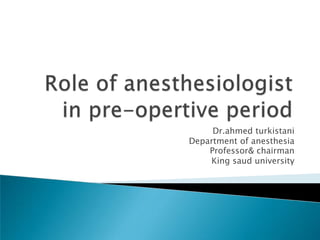
Role of anesthesiologist in pre-opertive period
- 1. Role of anesthesiologist in pre-opertive period Dr.ahmed turkistani Department of anesthesia Professor& chairman King saud university
- 3. To understand the objectives of preoprative visit.
- 4. To identify the risk factors in anesthesia.
- 5. To identify the lab tests needed before surgery.Objectives :
- 7. Stages of the Peri-Operative Period Pre-Operative From time of decision to have surgery until admitted into the OR theatre.
- 8. Stages of the Peri-Operative Period Intra-Operative Time from entering the OR theatre to entering the Recovering Room or Post Anesthetic Care Unit (PACU)
- 9. Stages of the Peri-Operative Period Post-Operative Time from leaving the RR or PACU until time of follow-up evaluation (often as out-patient)
- 10. To educate about anesthesia , perioperative care and pain management to reduce anxiety. To obtain patient's medical history and physical examination . To determine which lab test or further medical consultation are needed . To choose care plan guided by patient's choice and risk factors Preoperative visit.
- 11. Benefits from surgery ←-> Risk of complications
- 12. A thorough history and physical exam. Complete review of systems. Organ specific issues. Functional Status. Habits (smoking, alcohol, drugs). Medications (herbals) and allergies. Anesthesia history. Pre-op labs: one size does not fit all. Preoperative Evaluation:
- 13. Age Obesity Smoking General health status Chronic obstructive pulmonary disease (COPD) Asthma Patient related risk factors(pulmonary)
- 14. Smoking Important risk factor Smoking history of 40 pack years or more->↑risk of pulmonary complications stopped smoking < 2 months : stopped for > 2 months4:1(57% : 14.5%) quit smoking > 6 months : never smoked = 1:1 (11.9% : 11%)
- 16. Risk Stratification Revised Cardiac Risk Index High risk surgery (vascular, thoracic) Ischemic heart disease Congestive heart failure Cerebrovascular disease Insulin therapy for diabetes Creatinine >2.0mg/dL
- 17. Active Cardiac Conditions Unstable coronary syndromes Unstable or severe angina Recent MI Decompensated HF Significant arrhythmias Severe valvular disease
- 18. Minor Cardiac Predictors Advanced age (>70) Abnormal ECG LV hypertrophy LBBB ST-T abnormalities Rhythm other than sinus Uncontrolled systemic hypertension
- 20. Surgical Risk Stratification High Risk Vascular (aortic and major vascular) Intermediate Risk Intraperitoneal and intrathoracic, carotid, head and neck, orthopedic, prostate Low Risk Endoscopic, superficial procedures, cataract, breast, ambulatory surgery
- 21. Risk Stratification ASA physical status ASA 1 – Healthy patient without organic biochemical or psychiatric disease. ASA 2- A Patient with mild systemic disease. No significant impact on daily activity. Unlikely impact on anesthesia and surgery. ASA 3- Significant or severe systemic disease that limits normal activity. Significant impact on daily activity. Likely impact on anesthesia and surgery.
- 22. Risk Stratification ASA 4- Severe disease that is a constant threat to life or requires intensive therapy. Serious limitation of daily activity. ASA 5- Moribund patient who is equally likely to die in the next 24 hours with or without surgery. ASA 6- Brain-dead organ donor “E” – added to the classifications indicates emergency surgery.
- 23. Step #1:Is the surgery emergent? yes Is the surgery emergent? Operating room* no (Next Step) Consider beta-blockade, pain control and other peri-operative management
- 24. Step 2: Determine Presence of Active Cardiac Conditions If none are present, proceed with surgery Presence of one of these delays surgery for evaluation Many patients need a cardiac cath
- 25. Step 2 Unstable coronary syndromes Decompensated heart failure Significant arrhythmias Severe valvular disease
- 26. Step #2: Active Cardiac Conditions Evaluate and treat per current guidelines yes Active Cardiac conditions no Consider Operating Room (Next Step)
- 27. Step 3: Surgery Low Risk? Low risk surgery includes: Endoscopic procedures Superficial procedures Cataract surgery Breast surgery Ambulatory surgery Cardiac risk <1% Testing does not change management
- 28. Step #3: Surgery Low Risk? yes Operating room Low risk surgery No (Next Step)
- 31. Head and neck movement (extension)
- 32. Alignment of oral, pharyngeal, laryngeal axes
- 34. Airway Evaluation Oropharyngeal visualization Mallampati Score Sitting position, protrude tongue, don’t say “AHH”
- 35. Preoperative Testing Routine preoperative testing should not be ordered. Preoperative testing should be performed on a selective basis for purposes of guiding or optimizing perioperative management.
- 36. Preoperative Testing5 Procedure based. Low risk Baseline creatinine if procedure involves contrast dye. Intermediate risk Base line creatinine if contrast dye or >55yr of age. High risk CBC, lytes & S, creatinine as above. PFTs for lung reduction surgery.
- 37. Preoperative Testing Disease-based indications Alcohol abuse CBC, ECG, lytes, LFTs, PT Anemia CBC Bleeding disorder CBC, LFTs, PT, PTT Cardiovascular CBC, creatinine, CXR, ECG, lytes
- 38. Preoperative Testing Disease-based indications Cerebrovascular disease Creatinine, glucose, ECG Diabetes Creatinine, electrolytes, glucose, ECG Hepatic disease CBC, creatinine, lytes, LFTs, PT Malignancy CBC, CXR
- 39. Preoperative Testing Disease-based indications Pregnancy (controversial) Serum B-hCG- 7 days, Upreg 3 days Pulmonary disease CBC, ECG, CXR Renal disease CBC, Cr, lytes, ECG RA CBC, ECG, CXR, C-spine (atlantoaxial subluxation) AP C-spine, AP odontoid view and lateral flexion and extention.
- 40. Preoperative Testing Disease-based Sleep apnea CBC, ECG Smoking >40 pack year CBC, ECG, CXR Systemic Lupus Cr, ECG, CXR
- 41. Preoperative Testing Therapy-based indications Radiation therapy CBC, ECG, CXR Warfarin PT Digoxin Lytes, ECG, Dig level Diuretics Cr, lytes, ECG Steroids Glucose, ECG